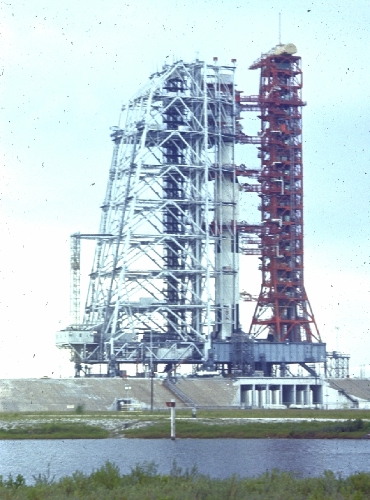 |
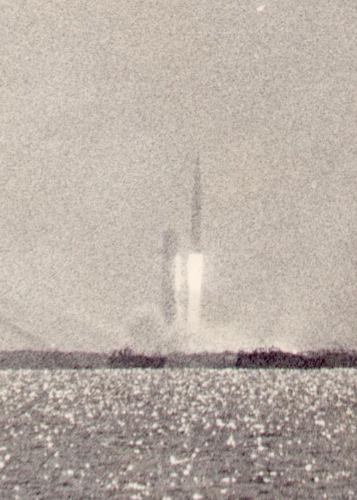 |
Watching satellites in Earth orbit has proven to be a popular and easy pastime. It may not be appreciated these days that it was possible to observe the Apollo spacecraft during transits between Earth and Moon. Many of these reports exist only in printed form, from a time before most electronic indexing has reached. This page begins to document telescopic observations of the Apollo lunar missions. It remains a work in progress, and I welcome further contributions and references. Small thumbnail images link to larger versions.
The first sightings of each mission were of course the launches, watched by hundreds of thousands of people lining the Florida beaches. I start the fun with these two images, which I took at age 13 before and during the launch of Apollo 15. |
 |
Enough of the boyhood reminiscences. Now on to the really distant views!
Apollo 8 was extensively tracked, owing to the great interest in the mission and the novelty of the lunar trajectory, as well as somewhat better illumination than some later missions. Many reports were collected in an article in the March 1969 issue of Sky and Telescope, "Optical Observations of Apollo 8" by Harold B. Liemon (Geo-Astrophysics Laboratory, Boeing Scientific Research Laboratories), pp. 156-160. The technical rationale for these observations, as a more or less coordinated program, was to explore the power of optical tracking for refining spacecraft orbits. In comparison with the usual Doppler range/rate data, optical observaatons trade poorly determined range and line-of-sight velocity for excellent angular location and transverse motion. Some of the following pictures are taken from that article, copyright 1969 by Sky Publishing Corp and reproduced with permission of the publisher and the photographer in each case. Original figure captions from this source are quoted below as [1]. Various professional observatories were notified in advance, with phone updates as needed, of the coordinates of Apollo 8 at observable times. As it neared the Moon and later returned, the spacecraft appeared against the stars of Aquarius and Pisces.
Multiple objects followed an Apollo in its path to the moon. For much of the way, until a major course correction, the four Spacecraft Lunar-Module Adapter (SLA) panels which which formerly protected the lunar module (or, for Apollo 8, a dummy mass taking the LM's place) would still be tumbling in the same telescopic field of view. For early missions, the Saturn V third stage itself (S-IVB) would remain close to the spacecraft as well. (One of these, likely from Apollo 12, was temporarily recaptured into a large orbit around Earth after 30 years in a solar orbit, in late 2002-2003). Most of the later S-IVBs were deliberately crashed into the moon, generating seismic signals of known strength and location to be picked up by the Apollo surface instrument packages).This artist's conception (NASA S68-51306) shows the panels being jettisoned from Apollo 8, while AS08-16-2584 is an Apollo 8 photograph showing the S-IVB after separation of the spacecraft and SLA panels.
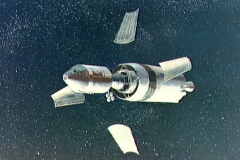 |
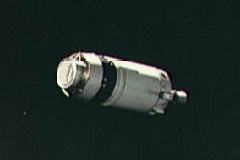 |
The brightest reflection to be seen from an Apollo stack would have been from the flat, Mylar-covered shades of the command module's windows. Liemohn calculated the expected magnitude of a specular reflection from these shades, which could be as bright as 10th magnitude in lunar orbit. In practice, most sighting in deep space were of the steadier diffuse reflection from the entire spacecraft, enlivened by the tumbling of the adapter panels.
 The first post-launch
sightings involved either the trans-lunar injection (TLI)
burn of the S-IVB engine or the dump of excess fuel from the stage shortly
afterward. The usual daylight launches and short time spent in the parking
orbit (which was lower than would be used for almost anything else,
to gain a little precious payload mass) meant that visual sighting opportunities
did not exist from the continental US until after the lunar missions
left Earth orbit. Parking orbits ranged from 165-190 km in mean altitude,
at inclinations 32-33 degrees.
The first post-launch sightings are represented by
a spectacular series of predawn photographs, shown at right, from
the Smithsonian
Astrophysical Observatory (SAO) station on Maui
(courtesy Smithsonian Astrophysical Observatory). The first one shows the TLI
burn near 15:44 UT on December 21. As the spacecraft passed Hawaii,
the changing perspective put the camera view looking up the sunlit
exhaust plume. For various missions, TLI took place between 2 hours 50 minutes
and 3 hours 12 minutes after launch (1.5-2.1 revolutions). John Stonesifer,
NASA Recovery Team Leader, deployed to the South Pacific aboard
the carrier USS Yorktown, both for planned recovery and in case of
early mission abort. He reports that the crew had an excellent view
of TLI from the carrier deck (and that a similar sight was visible
from the Hornet for Apollo 11). He notes somewhat ruefully that
"My biggest
disappointment was that with all the NASA photographers aboard as part of
our team we did not get any photographs of the sightings".
The first post-launch
sightings involved either the trans-lunar injection (TLI)
burn of the S-IVB engine or the dump of excess fuel from the stage shortly
afterward. The usual daylight launches and short time spent in the parking
orbit (which was lower than would be used for almost anything else,
to gain a little precious payload mass) meant that visual sighting opportunities
did not exist from the continental US until after the lunar missions
left Earth orbit. Parking orbits ranged from 165-190 km in mean altitude,
at inclinations 32-33 degrees.
The first post-launch sightings are represented by
a spectacular series of predawn photographs, shown at right, from
the Smithsonian
Astrophysical Observatory (SAO) station on Maui
(courtesy Smithsonian Astrophysical Observatory). The first one shows the TLI
burn near 15:44 UT on December 21. As the spacecraft passed Hawaii,
the changing perspective put the camera view looking up the sunlit
exhaust plume. For various missions, TLI took place between 2 hours 50 minutes
and 3 hours 12 minutes after launch (1.5-2.1 revolutions). John Stonesifer,
NASA Recovery Team Leader, deployed to the South Pacific aboard
the carrier USS Yorktown, both for planned recovery and in case of
early mission abort. He reports that the crew had an excellent view
of TLI from the carrier deck (and that a similar sight was visible
from the Hornet for Apollo 11). He notes somewhat ruefully that
"My biggest
disappointment was that with all the NASA photographers aboard as part of
our team we did not get any photographs of the sightings".
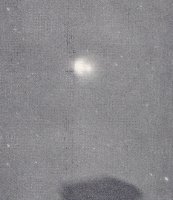 As the spacecraft began its climb outward from Earth, several amateur
astronomers
in the UK photographed a fuel dump from the expended S-IVB stage
shortly after 18:00 UT on December 21, 1968. This
event was seen, without prior notification, by F. Kent, Alan Heath, and
M.J. Oates, who reports catching the cloud visually while getting off
a bus.
photograph above is by M.J. Hendrie.
"At Colchester, England, M.J. Hendrie took a three-minute exposure beginning at
18:16 Universal time on december 21, showing blowout of excess fuel from the
third stage. The view is 5-1/2 degrees wide, and Theta Aquilae is at right
of the chimney." [1] In a 2003 letter, Mr. Hendrie notes that one of his
14 pictures was taken almost simultaneously with
one of the SAO tracking-camera
pictures from San Fernando, Spain, so that the spacecraft was displaced
against the background stars by parallax at a range of about 50,000 km.(Picture linked by permission of SAO)
As the spacecraft began its climb outward from Earth, several amateur
astronomers
in the UK photographed a fuel dump from the expended S-IVB stage
shortly after 18:00 UT on December 21, 1968. This
event was seen, without prior notification, by F. Kent, Alan Heath, and
M.J. Oates, who reports catching the cloud visually while getting off
a bus.
photograph above is by M.J. Hendrie.
"At Colchester, England, M.J. Hendrie took a three-minute exposure beginning at
18:16 Universal time on december 21, showing blowout of excess fuel from the
third stage. The view is 5-1/2 degrees wide, and Theta Aquilae is at right
of the chimney." [1] In a 2003 letter, Mr. Hendrie notes that one of his
14 pictures was taken almost simultaneously with
one of the SAO tracking-camera
pictures from San Fernando, Spain, so that the spacecraft was displaced
against the background stars by parallax at a range of about 50,000 km.(Picture linked by permission of SAO)
In Kent, well-known amateur astronomer Cdr. H.R. Hatfield made several tracking photographs. One of them was published in the Daily Mirror, along with an unusually detailed background, shown here as scanned and contributed by Paul White. (Photo reproduced by the kind permission of Mirrorpix.com.) From the accompanying text, this was a 3-minute exposure with Pentax camera and 150mm lens guided visually on the spacecraft (which was visible telescopically although not distinct in the wide-field picture). The writeup also makes the interesting point that ionization by energetic particles should contribute to the glow of such a fuel dump.
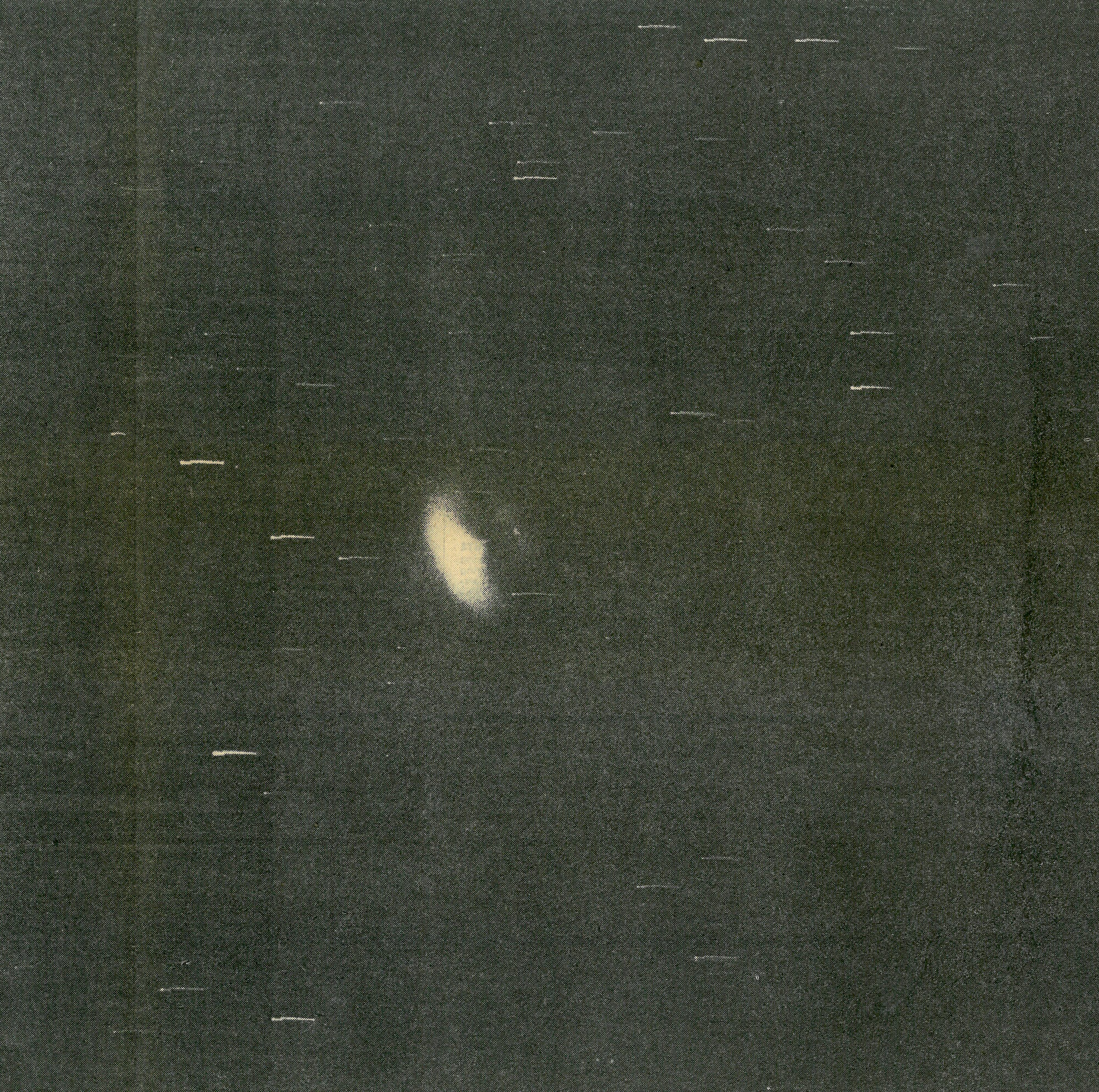
From the Spanish Naval Observatory (Observatorio de la Armada) in Cadiz, Oscare Rodriguez has found the following image of an S-IVB fuel dump. It's filed as Apollo 8, although a date scrawled on the back is more ambiguous at this point. The Apollo 8 dump was well seen from Spain. The May 1969 article in Sky and Telescope notes that the S-IVB vented fuel (liquid hydrogen) and oxidizer (liquid oxygen) separately in perpendicular directions, which appears in the two distinct clouds here
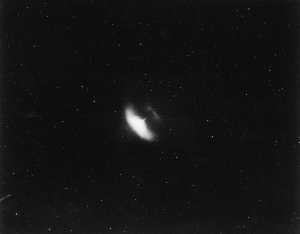
Reports of Apollo 8 sightings came from Pic du Midi Observatory (in the French Pyrenees); the Catalina Station of the Lunar and Planetary Laboratory (University of Arizona); Corralitos Observatory, New Mexico, then operated by Northwestern University; McDonald Observatory of the University of Texas; Lick Observatory of the University of California; the U.S. Naval Observatory station at Flagstaff, Arizona; and JPL's Table Mountain Observatory in California.
The first opportunity for large telescopes to view Apollo 8 en route to the moon fell to Pic di Midi. Dr. Michael Moutsoulas reported an initial sightig (near 17:10 UT on December 21) through the finder of the 1.1-meter reflector as an object (magnitude near 10, through clouds) moving eastward near the predicted location of Apollo 8. Moutsoulas moved to the 60-cm refractor because of a drive problem at the reflector, observing a cluster of objects. These were obscured by the appearance of a nebulous cloud, at a time which matches a firing of the service module engine to assure adequate separation from the S-IVB. This event can be traced with the Apollo 8 Flight Journal, noting that launch was at 0751 EST or 12:51 UT on December 21. Thus the Pic du Midi observations started at mission elapsed time 04:19. The separation burn of the srvice propulsion system (SPS) engine was performed at 04:45 elapsed time, matching the French site's observed time.
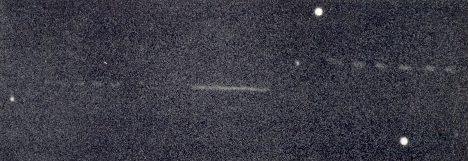
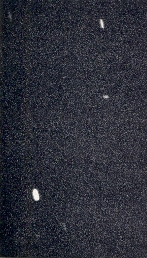 Lunar and Planetary Laboratory (LPL) pictures from the 1.54m telescope,
about eight hours later,
showed the spacecraft, S-IVB
booster stage, and some panel reflections. "In the Lunar and Planetary
Laboratory photograph above, Apollo 8 is the center trail; fainter booster
parts are to the left and right. Mid-exposure with the 61-inch reflector
was at 2:00:54 UT on the 22nd" [1].
"At left, on the 23rd at 2:05:10 UT, the stars trailed as Apollo 8 was tracked...
The S-IVB is below the bright star at lower left."[1] These photos used
by permission of Elizabeth Roemer and the Lunar and Planetary Laboratory.
Lunar and Planetary Laboratory (LPL) pictures from the 1.54m telescope,
about eight hours later,
showed the spacecraft, S-IVB
booster stage, and some panel reflections. "In the Lunar and Planetary
Laboratory photograph above, Apollo 8 is the center trail; fainter booster
parts are to the left and right. Mid-exposure with the 61-inch reflector
was at 2:00:54 UT on the 22nd" [1].
"At left, on the 23rd at 2:05:10 UT, the stars trailed as Apollo 8 was tracked...
The S-IVB is below the bright star at lower left."[1] These photos used
by permission of Elizabeth Roemer and the Lunar and Planetary Laboratory.
Observations (visual and photographic) were made with the Table Mountain 61-cm telescope on Dec. 22, 23, and 24. The spacecraft and booster were about equally bright om the evening of the 22nd, and still in the same eyepiece field at 130x. Video tape allowed timing of the flashes from both components; on the 22nd, there was a repeating cycle of 5, 5, and 18 seconds, which slowed the following night.
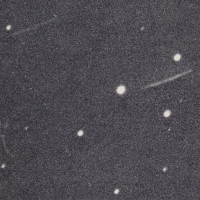 On the same nights, H. Ables, J. Christy, R.L. Walker, Jr., and
J. Wray used the 61-inch astrometric reflector of the US Naval
Observatory in Arizona to observe Apollo 8. They saw one steady
and four flashing objects in the 22nd (photographing all but the
two faintest flashing ones). By the 24th, the spacecraft registered
photographically but did not appear visually as it was closing in
on the Moon and became lost in its glare.
"Although more than halfway to the moon on December 23rd,
the command module appears as a bright trail (within a star triangle also
seen at right) on a 61-inch reflector photograph at 2:35:35 UT."[1]
(US Navy photograph).
On the same nights, H. Ables, J. Christy, R.L. Walker, Jr., and
J. Wray used the 61-inch astrometric reflector of the US Naval
Observatory in Arizona to observe Apollo 8. They saw one steady
and four flashing objects in the 22nd (photographing all but the
two faintest flashing ones). By the 24th, the spacecraft registered
photographically but did not appear visually as it was closing in
on the Moon and became lost in its glare.
"Although more than halfway to the moon on December 23rd,
the command module appears as a bright trail (within a star triangle also
seen at right) on a 61-inch reflector photograph at 2:35:35 UT."[1]
(US Navy photograph).
Likewise, on each night during translunar coast, TV images using an image orthicon were obtained by resident director Justus Dunlap and staff members at Corralitos Observatory (near Las Cruces, New Mexico, then operated by Northwestern University). They obtained over 400 short-exposure intensified images, giving very accurate locations for the spacecraft. Below left: "The module is a faint moving dot in the three TV views from Corralitos Observatory (350 miles southeast of Flagstaff) at 2:54, 3:05, and 3:08. Note the second moving dot at lower right."[1] Right: "Five Apollo objects are revealed by their motion in this composite photograph with the Corralitos 24-inch reflector. Taken December 22nd at 3:01:50 UT and 2-1/2 minutes later, the two negatives were superimposed and displaced horizontally (1/10 inch here). Stars appear as horizontal pars, but spacecraft components are shifted diagonally. The brightest images (integration time one second) are of two objects that were not quite resolved."[1] (Images used by permission of Elaine Halbedel, current director of Corralitos Observatory)
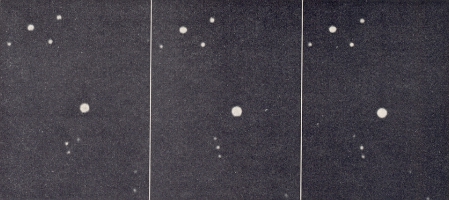 |
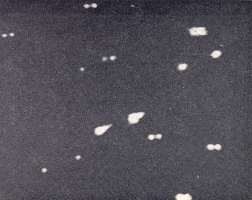 |
Anthony Fairall and Daniel Weedman observed Apollo 8 on December 23 using the 2.1m Struve telescope at McDonald, from 01:50-2:37 UT. The brightest object flashed, as bright as magnitude 15, with the flash pattern recurring about once a minute. The apparent motion at this point was so slow that nonflashing components would not have been visually distinctive. On the 35th anniversary of this sighting, Weedman wrote by email, "My wife and I were spending our first Christmas and were at McDonald where I was observing on the 82 inch. Everybody was celebrating the reports from Apollo so I decided to look for it. It was easily seen as a moving object in the telescope, and I invited all the staff who lived at the observatory and other visitors who were there to come and look at Apollo 8. It was a wonderful Christmas Eve experience for everybody, although it would have been spoiled if we had known how little would remain 35 years later of the Apollo promise."
The Lick observations during the return coast to Earth produced live TV pictures broadcast to West Coast viewers via KQED-TV in San Francisco. During the evening of December 26-27, the spacecraft started varying between magnitudes 14 and 17, brightening noticeably as the night proceeded and the spacecraft approached Earth. This variation was probably due to the rotation of the spacecraft, which spent most of the coast period in a slow roll ("barbecue mode") for temperature control. "TV-screen pictures from Lick Observatory, on December 27th. At left, the spacecraft is some 10 seconds of arc east (right) of a 12th- magnitude star (10.6 minutes of arc north-northeast of BD -10 4490), at 21:23:15 Pacific standard time. At right, Apollo 8 is in the upper right (northeast) corner." [1] (Image shown courtesy of Joe Miller).

James Young from Table Mountain notes that they tracked all the Apollo lunar missions except 17.
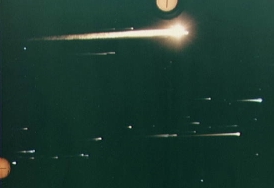 The final sightings, both deliberate and accidental, of each mission
would come during reentry over the Pacific. NASA added camera pods to the
Apollo Range Instrumentation Aircraft (later
Advanced
Instrumentation Aircraft, ARIA) platforms, generating
pictures such as S69-15592 of Apollo 8 (right), originally found
here
Numerous bits of
debris, presumably from the Service Module, appear as well as the
fireball around the Command Module.
The final sightings, both deliberate and accidental, of each mission
would come during reentry over the Pacific. NASA added camera pods to the
Apollo Range Instrumentation Aircraft (later
Advanced
Instrumentation Aircraft, ARIA) platforms, generating
pictures such as S69-15592 of Apollo 8 (right), originally found
here
Numerous bits of
debris, presumably from the Service Module, appear as well as the
fireball around the Command Module.
As reported in National Geographic (May 1969, p. 624), the Apollo 8 re-entry was seen by a planeload of passengers thanks to Captain James Holliday flying Pan Am flight 812, a Boeing 707 en route from Fiji to Honolulu on December 27, 1968. On spotting the re-entering spacecraft to port, he announced its location to the passengers. He noted, "We watched as the color of the capsule brightened to pinkish red, and we noticed a tail similar to that of a comet directly behind. The tail was short at first, a dull orange streak. As Apollo 8 gradually came closer in the star-filled black sky, its glow changed from soft orange to yellow and finally to incandescent white. The orange-red tail grew longer and more vivid. It did not flare; it was perfectly straight and of constant thickness, like the slash made by an artist on a piece of black velvet. We estimated the length of the tail at 125 miles. We watched the spacecraft for three minutes. By that time I had turned the plane around a full 180 degrees to follow it." Another Pan Am flight from Honolulu to Sydney had a ringside view, described in an article on page 2 of the Sydney Sunday Telegraph for Sunday, December 29, 1968 (scans by Colin Mackellar at honeysucklecreek.net). Additional sightings, and pictures, by airline passengers, have been reported at least for Apollo 11 and 13.
Numerous sightings of Apollo 10, and a photo from Leuschner Observatory, were reported in "Apollo 10 Optical Tracking", Sky and Telescope, July 1969, pp. 62-63. A NASA report describes visual and photographic tracking with telescopes located at the MSC site near Houston, and notes improvements since Apollo 8. The NASA volume Analysis of Apollo 10 Photography and Vsual Observations has a chapter on Earth-based sightings.
The ascent stage of the Apollo 10 lunar module finished its mission with an engine "burn to depletion", leaving it in a heliocentric orbit similar to Earth's. In 2011, a project was announced to search for it using the 2-meter Faulkes telescopes, incorporating the best estimates for its departing trajectory in 1969. More details from Nick Howe and Faulkes.
As for Apollo 8, John Stonesifer headed the recovery team for NASA. The team was already in the South Pacific at launch, and had a good view of the translunar injection burn of the S-IVB. He later met the pilot of a Pan Am flight (en route from Australia to the US) which had a similar view, and tried maneuvering the plane to let some of the passengers see it as well.
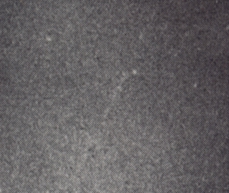 Sightings of Apollo 11, and a Table Mountain photo, were reported in
"Observations of Apollo 11", Sky and Telescope, November 1969, pp. 358-359.
The Table Mountain 60-cm image is shown here, by courtesy of Jim Young.
It is a 12-minute exposure (0512-0524 UT on 24 July, on the home stretch)
with the spacecraft showing as the diagonal
streak. There were few sightings from North America during the outbound
journey due to clouds over many sites. However, Brian Fenerty reports, "When
Apollo 11 was outbound towards the Moon, I was in Victoria, British
Columbia, Canada, and saw the mission on its way with my own eyes (from Saxe
Point Park by the ocean). One of the newspapers published a map showing
where to look in the evening sky on two consecutive nights, showing where
each night the craft would show as a point of bright light. Since I knew
enough about what was normally visible, it was unmistakable."
Sightings of Apollo 11, and a Table Mountain photo, were reported in
"Observations of Apollo 11", Sky and Telescope, November 1969, pp. 358-359.
The Table Mountain 60-cm image is shown here, by courtesy of Jim Young.
It is a 12-minute exposure (0512-0524 UT on 24 July, on the home stretch)
with the spacecraft showing as the diagonal
streak. There were few sightings from North America during the outbound
journey due to clouds over many sites. However, Brian Fenerty reports, "When
Apollo 11 was outbound towards the Moon, I was in Victoria, British
Columbia, Canada, and saw the mission on its way with my own eyes (from Saxe
Point Park by the ocean). One of the newspapers published a map showing
where to look in the evening sky on two consecutive nights, showing where
each night the craft would show as a point of bright light. Since I knew
enough about what was normally visible, it was unmistakable."
A group with the Chabot Observatory 50-cm refractor managed to detect it as late as 0425 UT on July 18, and again during the return on July 23. Amateur telescopes on Mount Kobau in British Columbia followed the final night of the return trip.
Update: Qantas pilot Frank Brown saw the re-entry of Apollo 11 from a Boeing 707 near the Gilbert and Ellice Islands (today Kiribati and Tuvalu, respectively). Colin Mackellar provides details in his Honeysuckle Creek site. Particularly noteworthy are the MP3 audio from Australian news coverage including Capt. Brown's live description of the re-entry and an article from the Sydney Sun-Herald with a photograph of Capt. Brown and his description, including the disintegration of the jettisoned service module. 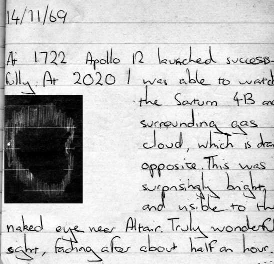 The apparent path of Apollo 12 was widely reported in the UK press.
Taking advantage of rapid clearing after a rain, Jonathan Silverlight used
a 75mm refracting telescope from a London suburb to make this sketch
of the S-IVB and surrounding cloud (14 November 1969, 1920 UT;
almost three hours after launch, which would make this sighting
right around the end of the TLI burn). His notes show that it
was a prominent naked-eye object. (In reading the times on these
notes, keep in mind that British Summer Time was in effect year-round
in 1969, so these are UT plus one hour; launch occurred
at 1622 UT.)
The apparent path of Apollo 12 was widely reported in the UK press.
Taking advantage of rapid clearing after a rain, Jonathan Silverlight used
a 75mm refracting telescope from a London suburb to make this sketch
of the S-IVB and surrounding cloud (14 November 1969, 1920 UT;
almost three hours after launch, which would make this sighting
right around the end of the TLI burn). His notes show that it
was a prominent naked-eye object. (In reading the times on these
notes, keep in mind that British Summer Time was in effect year-round
in 1969, so these are UT plus one hour; launch occurred
at 1622 UT.)
From Paul Maley's page, here is a TV image of Apollo 12 (as the tip of the labelled arrow) accompanied by two of the flashing SLA panels (below the right arrow). This was taken at 0200 UT on 14 November 1969, at a range of about 50,000 miles (80,000 km). An image intensifier was used on a 16-inch telescope.
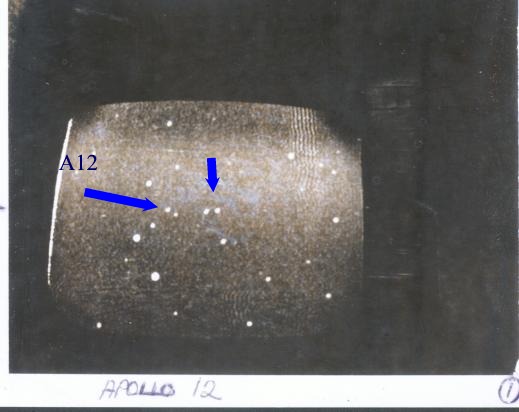
Numerous visual and photographic reports of Apollo 12 were given in "Optical Observations of Apollo 12", Sky and Telescope, February 1970, pp. 127-130. Among these were the following series of sketches by Maurice Gavin, done from Worcester Park in the UK (reproduced by permission; see also Maurice Gavin's site).This series made from 2105-2120 UT on November 14, 1969, during the second venting of liquid oxygen from the S-IVB.

At a range of about 110,000 km, the team at Corralitos Observatory was the first to record a water dump from an Apollo spacecraft. The sequence below (courtesy of Elaine Halbedel, Corralitos Observatory, and Sky and Telescope magazine) spans the interval 0421-0446 UT on November 15. The ejected water cloud (W) is seen moving away from the spacecraft (SC); numbers 1-4 indicate tumbling SLA panels. These are image-orthicon TV images.
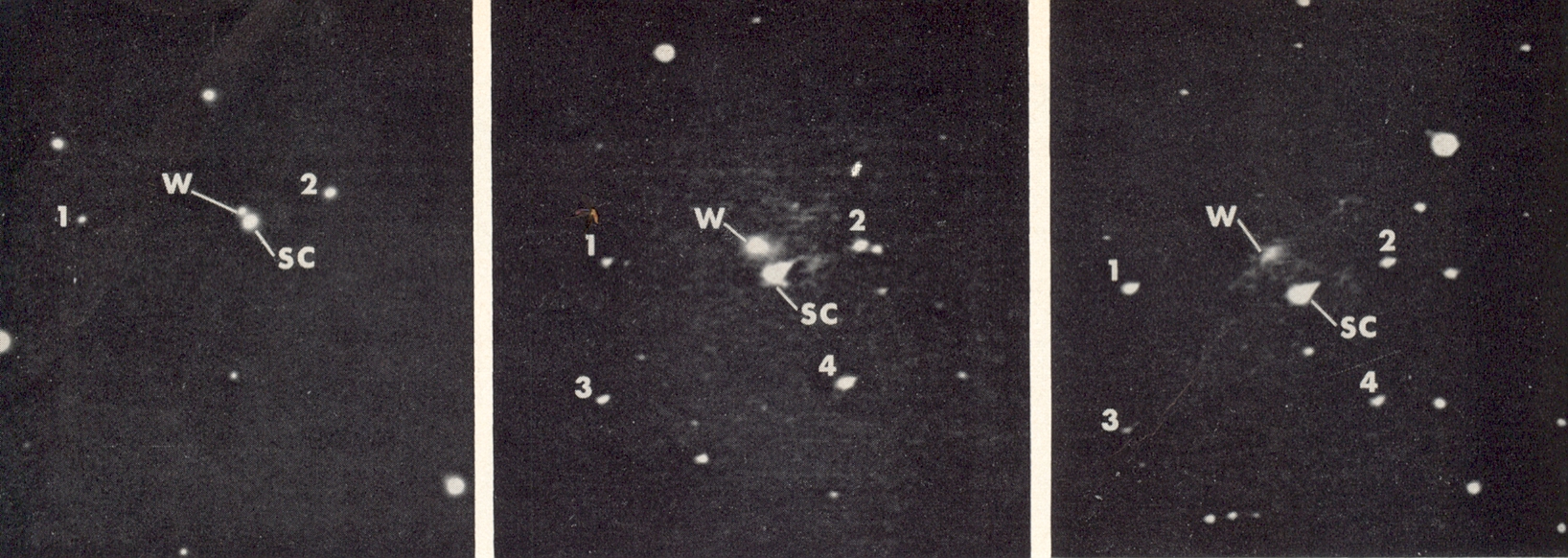
This image of Apollo 13 is also shown courtesy of Paul Maley's page. It's similar to the Apollo 12 example in provenance. This image shows a water dump at 0214 UT on 13 April 1970, accounting for the fuzzy image of the spacecraft. Such water dumps are also notable from space shuttles, sometimes looking like a curved searchlight beam arcing below the orbiter. Paul Maley has a video image of such a water dump here, that was just after release during an HST servicing mission, and it happens I saw the same water dump from Alabama and wondered how they had the nerve to dump so close to the telescope, no matter how firmly Newton and Kepler say the material would move the other way.
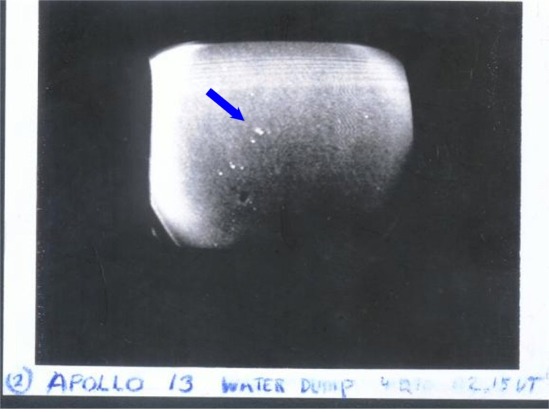
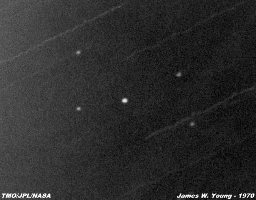 Jim Young also presents this
photograph of
Apollo 13 from Table Mountain, from 0523-0528 UT on April 12, 1970
(two days before the explosion). The spacecraft itself shone steadily
at magnitude 13, while the SLA panels occasionally flashed as bright as
magnitude 9 (too seldom to show up very brightly in this long-exposure
image). Picture reposted here by kind permission
of J. Young.
Jim Young also presents this
photograph of
Apollo 13 from Table Mountain, from 0523-0528 UT on April 12, 1970
(two days before the explosion). The spacecraft itself shone steadily
at magnitude 13, while the SLA panels occasionally flashed as bright as
magnitude 9 (too seldom to show up very brightly in this long-exposure
image). Picture reposted here by kind permission
of J. Young.
Ron Welch visually observed Apollo 13 outbound, at about 100,000 km range, using the Zeiss 0.5-m Cassegrain telescope at Auckland Observatory in New Zealand.
There have been several reports of ground-based observations of the explosion on Apollo 13 (pointers to more are welcome). Two Corralitos images showing fading of the cloud were reproduced in "The Apollo 13 Accident", Sky and Telescope, July 1970, p. 14 (below upper panels, courtesy of current Corralitos director Elaine Halbedel and Sky and Telescope). NASA photo S70-34857 (below, lower) is labelled in the official caption as showing the O2 cloud, which would make it immediately post-explosion. This may be the one by Indulis Saulietis et al. of what is now JSC mentioned in one German-language WWW reference
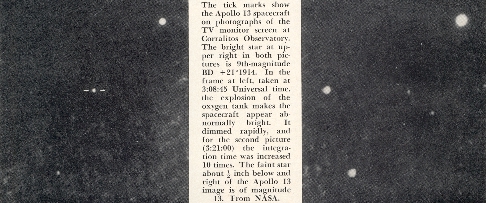
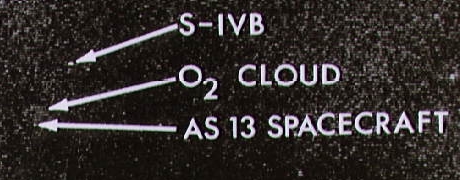
In a 2011 email, quoted by permission, Jim Gallivan provided further information on the Corralitos observations: "In particular with respect to the Apollo 13 shots, my wife, Mickey Gallivan and I took the photographs that you have on your site. We had been following the spacecraft with coordinates NASA computed for our position. Yes, the panels would flash at regular intervals. When the explosion happened it was obvious something strange had happened. I remember my wife asked me if I thought the astronauts were still alive."
"Immediately after the explosion I called NASA, We kept watching the spacecraft and reporting the coordinates and the direction of the ejected materials to NASA. There was quite a bit of drama as Houston and the astronauts were not sure what had happened and we were able to visually report on what we saw. Copies of the imagery we took that night were flown on a special flight to Houston."
"We were expected to continually track the spacecraft for NASA and had a lot of images of its progress. I am very sure Corralitos was the only site to take a photograph or see the actual explosion. We kept the photos away from public release until Apollo 13 had safely returned, which was not a certain thing. Later they were published in the New York Times and later in Sky and Telescope. For Apollo 14 and 15 we had network TV trucks on site and monitoring our imagery of the flights."
In 2013, I received images showing the Apollo 13 explosion cloud, from Tom Younger (as taken by his father Frank Younger and Ernie Pfannenschmidt). Younger and Pfannenschmidt were photographing the spacecraft en route to the Moon using the 0.4m telescope on Mount Kobau in British Columbia, and captured this "before and after" set, here rotated to have north at the top. The originals were on 3.25x4.25-inch photographic plates (listed as out-of-date, processed in Kodak D-19 developer), information which lets us set the scale of the images based on a scan of the entire field. (The site and telescope are described at length in this paper by Brosterhus, Pfannenschmidt, and Younger). The Boller & Chivens 0.4m telescope at f/18 gave an image scale near 28.6 arcseconds/mm so the short axis of the plate spanned 38 arcminutes (0.63 degrees). The cloud in the "after" image thus subtends a longest diameter of about 37 arcseconds (verified by background star patterns below). For a spacecraft distance 322,000 km, this projects to about 60 km. This "after" photograph is the clearest registration of the explosion cloud I've seen. Younger and Pfannenschidt were simultaneously taking a series of wide-field photographic plates with an 83mm lens as well as the 40-cm telescope. While these photographs did not reach deep enough to pick up any of the Apollo mission elements, they used the plate envelopes to immediately record what they saw visually through the 40-cm telescope.
 |
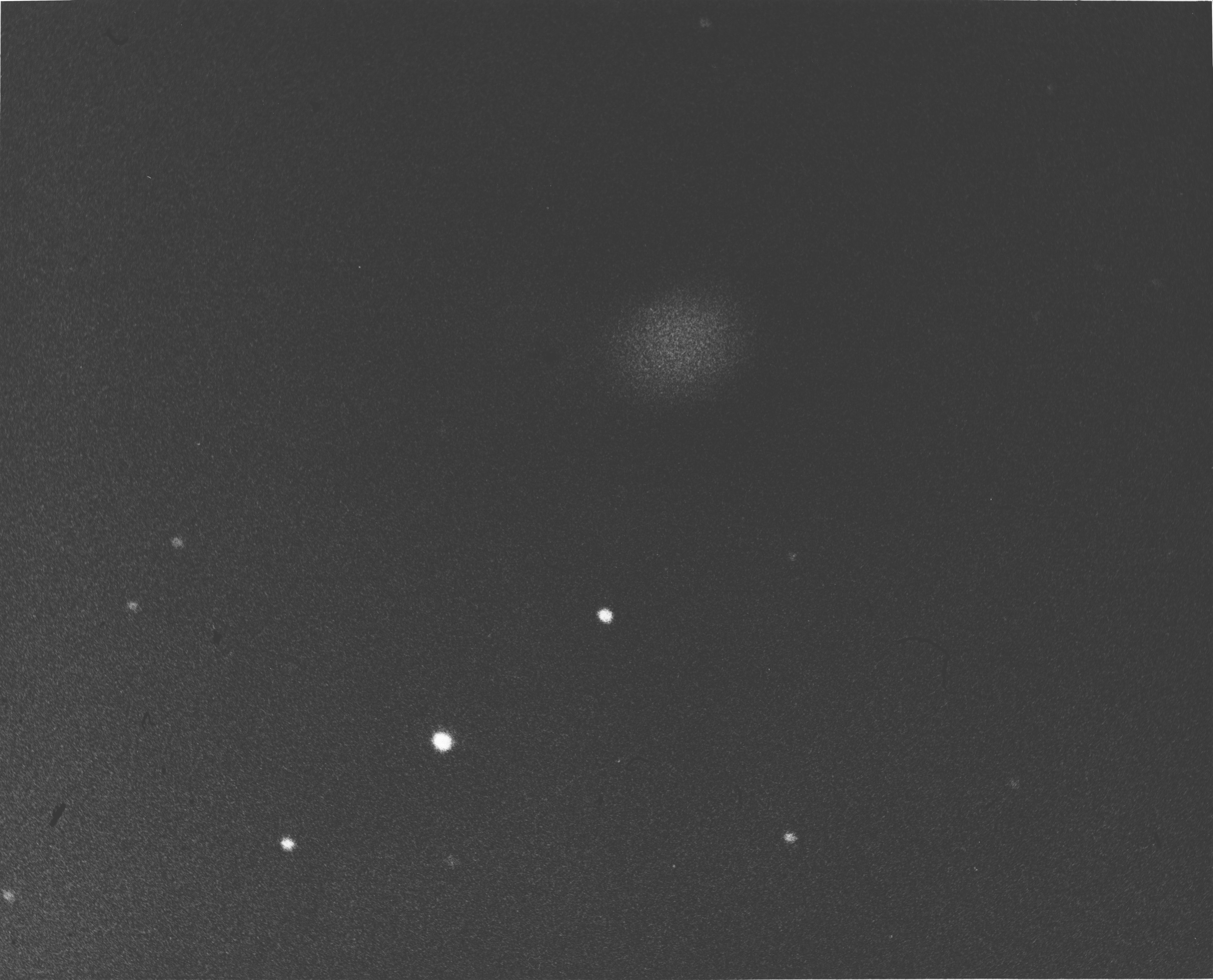 |
With calculations provided by Cees Bassa, it was possible to identify the star field in these images. Using a paper by Daniel Adamo giving positions and velocities at important maneuvers, he could backtrack to the explosion time. The star field put the spacecraft within 1500 km of this rough prediction, within its expected error range. At the time, observers at Mt. Kobau saw Apollo 13 appear just to the east of the Beehive (Praesape) in Cancer. Using representation from Palomar Sky Survey photographs, I estimate the spacecraft coordinates to have been right ascension 8h 39m 46s, declination +20° 21' 39". The brightest star is 9th magnitude. This excerpt from the WikiSky image rendering of Palomar Sky Survey photographs shows the star pattern. The sky was pretty bright for these exposures, since the explosion occurred soon after sunset as seen from Mt. Kobau. Scott Ferguson greatly improved my rough position estimate, but using astrometry.net to do a proper astrometric solution: 08h 48m 42.81s, Dec: +20d 10' 23.5" (equinox 2000).
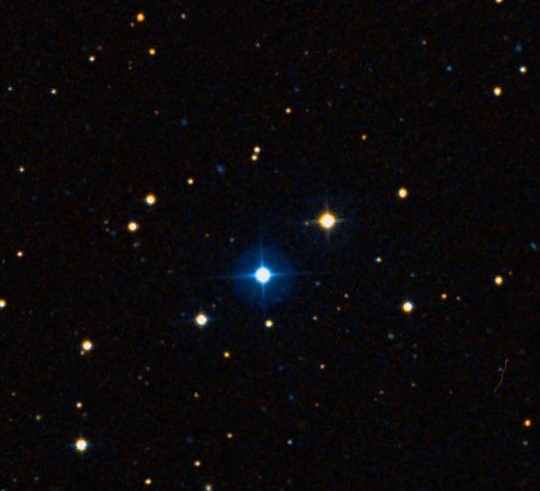
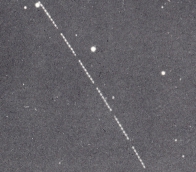 Meanwhile, the S-IVB continued toward the moon, its Newtonian motion
heedless of the drama in its former payload. Here is a Naval
Observatory 1.54-m telescope image of the booster 230,000 km
from Earth, flashing as it tumbles; the shutter was closed for
one of every five minutes during this 30-minute exposure to
provide timing information. The original negative included the trails
of Apollo 13 itself as well as the ubiquitous SLA panels. (US Navy
photograph, reproduced by permission from Sky and Telescope,
October 1971).
Meanwhile, the S-IVB continued toward the moon, its Newtonian motion
heedless of the drama in its former payload. Here is a Naval
Observatory 1.54-m telescope image of the booster 230,000 km
from Earth, flashing as it tumbles; the shutter was closed for
one of every five minutes during this 30-minute exposure to
provide timing information. The original negative included the trails
of Apollo 13 itself as well as the ubiquitous SLA panels. (US Navy
photograph, reproduced by permission from Sky and Telescope,
October 1971).
The Chabot Observatory calendar records an application of optical tracking during the final phases of Apollo 13, on 17 April 1970. "Rachel, Chabot Observatory's 20-inch refracting telescope, helps bring Apollo 13 and its crew home. One last burn of the lunar lander engines was needed before the crippled spacecraft's re-entry into the Earth's atmosphere. In order to compute that last burn, NASA needed a precise position of the spacecraft, obtainable only by telescopic observation. All the observatories that could have done this were clouded over, except Oakland's Chabot Observatory, where members of the Eastbay Astronomical Society had been tracking the Moon flights. EAS members received an urgent call from NASA Ames Research Station, which had ties with Chabot's educational program since the 60's, and they put the Observatory's historic 20-inch refractor to work. They were able to send the needed data to Ames, and the Apollo crew was able to make the needed correction and to return safely to Earth on this date in 1970."
Terry Galloway, team leader for Apollo tracking at Chabot Observatory, provides more detail as follows: "We did team with BellComm of Washington DC and NASA to conduct optical tracking of Apollo spacecraft from Apollo 7 through 17. We supplied the rotational rate decay of the ejected SLA panels which was used to help quantify the tiny residual atmospheric air resistance at the high altitude flights. We were also asked to provide our best positional coordinates of the tracked spacecraft from the specular reflection against the backdrop of stars in order to refine BellComm's orbital computations. We noted water dumps, spacecraft separations and redocking, timings, etc. Some photographic documentation was done on selected missions when there were spectacular visual events. We did this observational work with Chabot's three telescopes: the 20" Brashear Refractor, the Mellish-Smith 9.5" refractor, and the Alvan Clark 8" refractor with the able assistance of many high school students and some college students. I think we were most noted for our observations of Apollo 13. As the only observatory with clear skies and tracking Apollo 13 at the critical time, in response to NASA's urgent phone call, we provided to NASA/Houston critical real-time positional information to assist in the manual re-entry of Jim Lovell and his crew. This is a brief summary, but I hope will give you something of the scope of our work. Reports of each Apollo mission were prepared and submitted to BellComm. My own personal records were lost in the Berkeley Firestorm of 1991. This Apollo optical tracking program was a great success for us and changed the lives of many of our students, most of whom have entered various fields of science and some particularly noteworthy in astronomy today".
The re-entry was seen by the crew and passengers on an Air New Zealand DC-8 bound from Nadi (or Nandi, in Fiji) to Auckland. A full account was given in the next morning's edition of the Auckland Star. Peter Gabelish was among the passegers, and supplies the following recollections based on entries he made in a pocket diary at the time.
I found myself on a southerly flight across the Pacific to Auckland with the vague feeling that our route would be close to Apollo 13's re-entry trajectory. I was on my way home from a stint in the US and Apollo 13 was big news, particularly in the States, as the three crewmen on board the stricken spacecraft fought for their lives. We were no sooner seated for take off than a rather excited pilot announced, "you may or may not be aware that we are expected to see Apollo 13's re-entry into the earth's atmosphere. We are in communication with Houston and will be the first to see the returning spacecraft. Houston want us to remain in contact until vehicle recovery".
Much excitement on board as everyone who had a camera set it up for the spectacle. Fortunately I had a camera that allowed me to set shutter speed, aperture etc., unlike the average modern camera that won't let you do much except point and shoot. Having figured out what I thought would work I proceeded to advise a fellow passenger on settings. It turned out that he was a professional photographer assigned by a newspaper for the event. I hope he appreciated my advice as my photos came out beautifully on my basic equipment.With the cabin lights out we waited expectantly. Running about two minutes behind schedule a brilliant fire ball, like a massive Very light appeared over the starboard horizon! Travelling horizontally, an incandescent, silver plume of brilliant light, leaving a blazing trail of constant width behind it, arced in from the west at an altitude that didn't appear to be much higher than ours. The silver phosphorescent tail it left behind seemed to retain its brilliance as a curved band of luminescent material while the leading body continued at constant velocity across our path. I presumed the tail to be the vaporized aluminium and magnesium materials from which the capsules were mostly constructed. My reaction was that no one could live through the incredible fireworks and that all must be lost. Every few seconds a bright yellow-orange spark would branch off the main spearhead and arc away on a different trajectory.
The incredible display continued across our path and arced towards the eastern horizon on our port side. The inferno diminished while still within our sight. When it died out, a minute red dot continued on the east bound path, curving out of sight over the horizon. This was the command module with its glowing heat shield that had survived the impossible inferno and miraculously had living humans alive inside it. I would guess that the whole display lasted three to four minutes.
We were fortunate that the whole re-entry was seen in total darkness. Several minutes afterwards day began to break and the trail of vaporized metal was visible hanging in the upper atmosphere for the next twenty minutes or so affording me the chance to photograph it as it hung there. The next morning the Auckland Star carried a photograph of the re-entry proclaiming that the passengers on our flight had been the sole witnesses to "The Sight of a Lifetime". It seemed that their photographer was lucky enough to get it right too! Perchance he used the settings I gave him?
He also provides this picture he took of the re-entry trails a few minutes later:
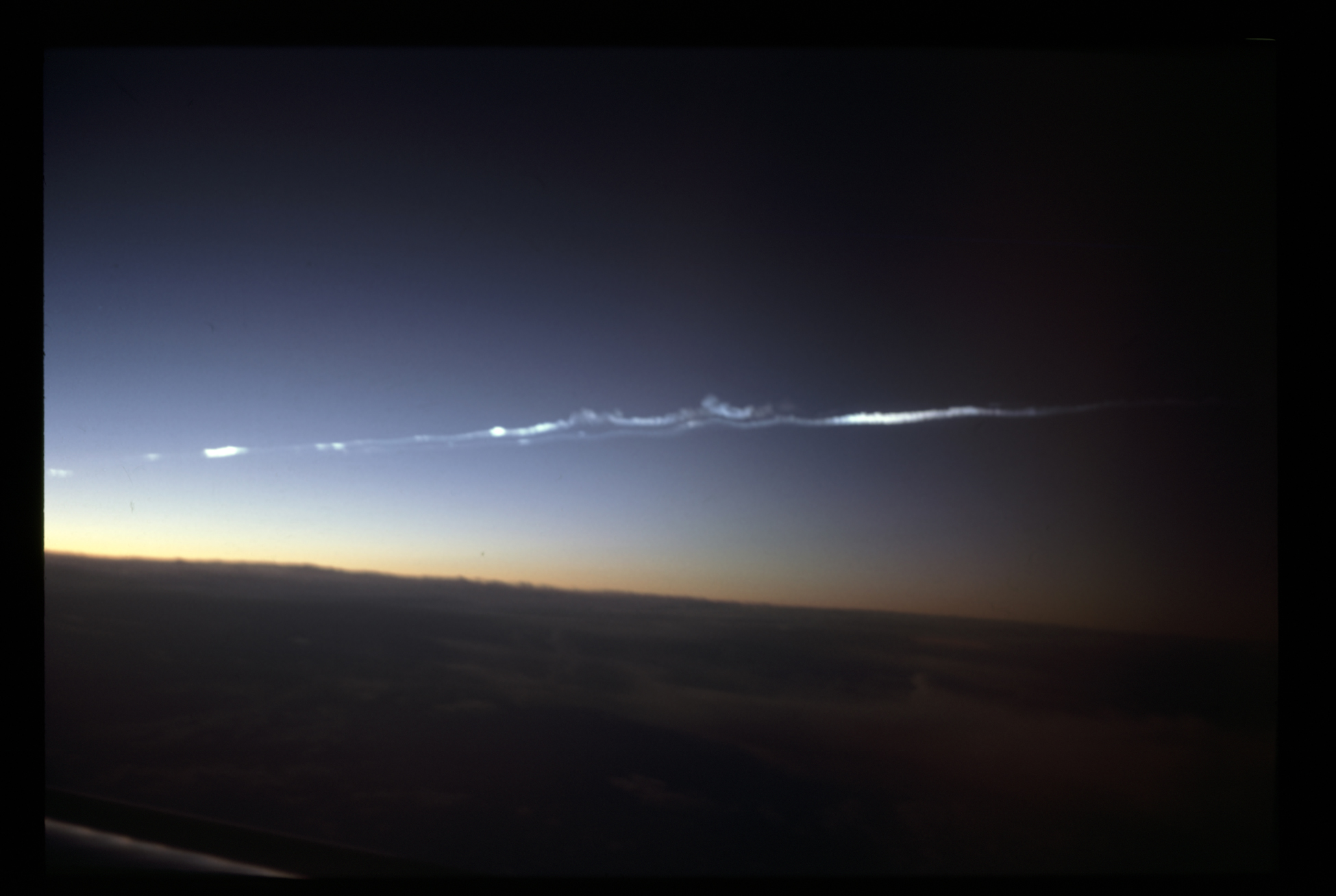
This image of Apollo 14 during a water dump (including SLA panels) is provided in an archival image courtesy of current director Elaine Halbedel, from the Corralitos Observatory files. This was done with a TV system on the 24-inch reflector. The motion of the objects brings out not only the spacecraft and S-IVB booster stage, but the four SLA panels.
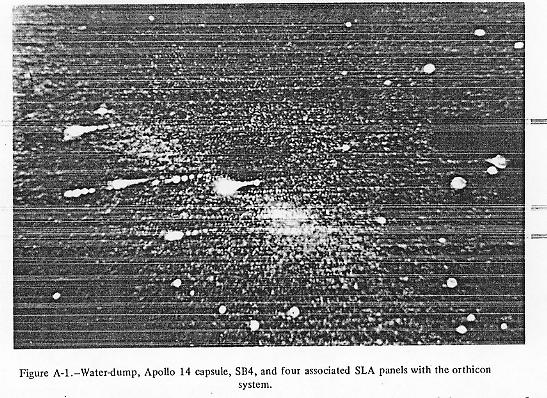
Ron Welch visually observed the Apollo 14 return or re-entry from Auckland, New Zealand.
Dale Ireland reports observing the Apollo 16 spacecraft (CSM+LM) and S-IVB using the 12-inch f/15 Clark refractor at Jewett Observatory at Washington State University. Each was typically magnitude 11 or 12.
I have yet to find any sightings of Apollo 17. However, this is an excellent place to link to Sven Grahn's report of amateur tracking of this mission by radio, including astronaut voices from the Moon. More recently, copies have turned up on the Web of a newspaper story about the success of Kentucky radio amateur Larry Baysinger in picking up signals and voice from Apollo 11. This link includes a scan of the contemporary newspaper story, followup interviews, and MP3s of his recordings of conversation snippets (during the lunar EVA).
During later missions, press releases distributed before launch included right ascension and declination for the spacecraft path as seen from various parts of the US, assuming an on-time launch.
In this time of rampant conspiracy theories, one point of documenting these observations is to demonstrate independent evidence, from non-governmental observers, that large objects exhibiting exactly the configuration and behavior of the Apollo spacecraft were seen en route to and from the Moon.
At least the final Lunar Orbiter mission was also tracked optically in lunar orbit. Since Apollo, spacecraft in very high orbits have been imaged by well-equipped amateurs (Chandra, XMM-Newton) and reflections from deliberately oriented solar panels have allowed NEAR-Shoemaker to be detected with modest means at a range of 25,000 km or so. The Wind spacecraft was discovered at roughly lunar distance by asteroid searches, both professional and amateur (2001 DO47 turned out to exhibit an attention-getting trajectory change which led to its identficatgion as the WIND spacecraft; here are notes from the Spacewatch project and Minor Planet Center. More recently, Earth-approaching "asteroid" 2007 VN84 turned out to be ESA's Rosetta spacecraft inbound for a gravitational-slingshot maneuver. Our campus observatory's 0.4-meter telescope was able to image LCROSS (dot centered in each image, tracking the spacecraft motion against the background stars) in July 2009, at about 1.3 lunar distances. These observations also show how far we've come, at least on the ground side of things.
Acknowledgements. The following people have provided pictures, pointers, permissions, or corrections for this material, and I am happy to publicly thank them: Cees Bassa, Geoff Chester, Mike Drake, Brian Fenerty, Scott Ferguson, Peter Gabelish, Jim Gallivan, Terry Galloway, Maurice Gavin. Elaine Halbedel, M.J. Hendrie, Sally MacGillivray, Paul Maley, Colin Mckellar, Joe Miller, Jeff Pier, Vladislav Pustynski, Oscar Rodriguez, Elizabeth Roemer, Jonathan Silverlight, John Stonesifer, Dan Weedman, Ron Welch, Paul White, Jim Young, Frank and Tom Younger.
The Web contains some marvelous resources with enormous detail about the Apollo program, many of them labors of love by a few individuals. Some especially useful ones are:
In more tangible media, there is a vast array of material in Apogee Books' collection of NASA Mission Reports and Spacecraft Films' newly compiled DVD sets. If I can find these locally in Alabama, and outside of Huntsville, they're not that hard to locate...
(ostentatious throat-clearing) "The views, opinions, and conclusions expressed in this page are those of the author and not necessarily those of The University of Alabama or its officers and trustees. The content of this page has not been reviewed or approved by The University of Alabama, and the author is solely responsible for its content. "
wkeel@ua.eduLast changes: November 2021